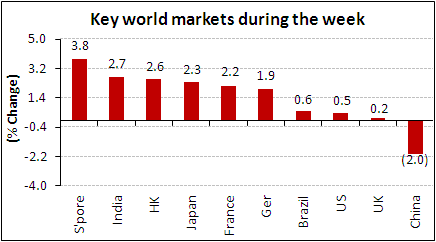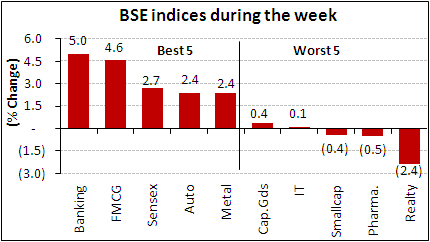India's Third Giant Leap
This Could be One of the Biggest Opportunities for Investors
- Home
- Todays Market
- Indian Stock Market News September 21, 2013
Central banks influence global markets Sat, 21 Sep RoundUp
In the week gone by, barring China, majority of the global stock markets closed in the green. The rally was fueled by the US Federal Reserve postponing its decision to taper the QE program US Federal Reserve has postponed the decision to taper the huge monetary stimulus. Various emerging as well as European markets climbed after the Fed's decision. However, the party did not last long. During the week's last trading day, various global markets witnessed selling pressure. One Federal Open Market Committee member signaled that the Fed could curb stimulus measures next month though this may not happen in September. The investors reacted to this uncertainty negatively and a heavy selloff was witnessed on Friday.
During the week, Fed Chairman Mr Ben Bernanke had announced that the Fed will wait for evidence of strong economic growth before taking such a step. However, the announcement of possibly curbing stimulus in the last trading session intensified selloffs in the US and various other markets.
As far as the Indians tock markets are concerned, while the Fed's decision earlier fuelled a rally, the new RBI governor announcing a 25 bps hike in the repo rate dampened sentiments on Friday. As a result, Indian markets sunk into the red. The RBI move was in line with the inflationary pressures that continue to plague the Indian economy.
 |
| Source: Yahoo Finance |
Majority of the sectoral indices ended in the green with Banking (up 5%) and FMCG (up 4.6%) witnessing maximum buying interest. Only stocks from Pharma and Realty closed in the red. The small cap stocks also witnessed selling pressure.
 |
| Source: BSE |
Now let us discuss some of the economic developments of the week gone by.
Wholesale price index (WPI) inflation rose at the fastest pace for six months in August, driven by an 18% jump in food prices. WPI based inflation rose to a six-month high of 6.1% in August against 5.79 in July, according to the data released by Ministry of Commerce and Industry. Food inflation stood at a massive 18.1% in August against 11.9% in July. The inflation in vegetables soared to 77.8% in August against 46.5% in the previous month. Onion prices rose by a mammoth 244.6% against 144.9%. The inflation for manufactured products eased to 1.9% against 2.8% in July. Inflation in fuel and power rose marginally to 11.3% in August from 11.3% in the previous month.
The governor in its maiden Mid-quarter Monetary policy yesterday surprised one and all. The new Governor has hiked the repo rate by 0.25% to 7.5% citing concerns on persistent higher inflation. Some respite came in with the Central Bank addressing the volatility in the exchange market. To that effect, the marginal standing facility (MSF) rate has been reduced by 0.75% from 10.25% earlier to 9.5%. Besides the Central bank has lowered the minimum daily CRR or cash reserve requirement for banks which came as a welcome move.
In our opinion, the marginal hike to the repo rate will not do much to change the liquidity scenario in the banking system. In fact even the marginal breather in terms of overnight lending rate (via MSF) is just a temporary measure. However, given the possible inflow of cheap money into the economy, a liquidity tightening mode will certainly arrest asset bubbles.
| Company | 13-Sep-13 | 20-Sep-13 | Change | 52-wk High/Low | |
| Top gainers during the week (BSE-A Group) | |||||
| Yes Bank | 281 | 356 | 26.7% | 547/216 | |
| JSW steel | 632 | 741 | 17.2% | 894/452 | |
| GMR Infra | 19 | 22 | 14.8% | 27/11 | |
| Shriram Transport | 559 | 636 | 13.8% | 842/465 | |
| LIC housing | 184 | 207 | 12.9% | 300/152 | |
| Top losers during the week (BSE-A Group) | |||||
| Ranbaxy Labs | 457 | 333 | -27.1% | 560/254 | |
| Gitanjali Gems | 72 | 59 | -17.4% | 650/57 | |
| Opto Circuits | 26 | 22 | -13.8% | 142/18 | |
| Muthoot Finance | 114 | 99 | -13.0% | 246/74 | |
| Financial Tech | 199 | 174 | -12.6% | 1224/102 | |
Now let us move on to some news from the corporate world.
The stock of Ranbaxy Laboratories corrected by 27.1% during the week. This was on back of the US Food and Drug Administration (USFDA)'s import alert on its Mohali plant. According to a leading business daily, Form 483 was also issued to the company for its Mohali plant earlier. This indicates there were certain discrepancies in manufacturing practices which the US FDA had pointed out earlier. However, since the company failed to comply with those issues, an import alert has been issued. In November 2012 as well, the USFDA had directed for the recall of its generic drug Atorvastatin (Lipitor) which was being manufactured at the same Mohali facility. It was reported that glass particles were found in certain lots of the drug. The company was supposed to be working with USFDA for the implementation of corrective measures.
As per a leading financial daily, state run, Oil and Natural Gas Corporation Ltd, (ONGC) and Royal Dutch Shell intend to exercise their pre-emption rights to buy a 35% stake in a Brazilian oil block which Petrobras was planning to sell to China's Sinochem Group. Petrobras had agreed to sell the block to Sinochem Group for US$ 1.54 bn last year. The block has been in production since 2009 and has produced more than 70 million barrels of oil equivalent so far. As per Shell, the second phase development of the block is likely to start by the end of the current year. Post the second phase development, the peak production from the block is expected to be around 35,000 barrels of oil equivalent per day. ONGC currently has a 15% stake in the block. Theoretically, it entitles ONGC to a further 8% stake from the 35% stake that Petrobras is planning to sell to Sinochem. Shell is the operator in the block with 50% share. While there has been no confirmation yet, as per the daily, ONGC plans to buy between 10% to 15% share in the block (higher than its entitlement) while Shell is likely to buy between 20-25% from Petrobras. This will be the first case of an Indian oil exploration and production company exercising its pre-emption rights to block the sale of an oil block to a Chinese firm.
As per various sources, National Thermal Power Corporation (NTPC) has envisaged capex of Rs 200 bn during FY14 for expansion. This is slightly higher than the Rs 199.2 bn that the company had spent in FY13. The firm added 4,170 MW of capacity including 1,000 MW through its joint venture projects in the last fiscal. The company's power generation capacity has reached 41,187 MW. In addition to this, the Cabinet Committee on Investment (CCI) has restored coal linkage to the company's proposed 1,980 MW North Karanpura power plant in Jharkhand. Funding may not really be an issue for the company given its relatively strong balance sheet as compared to its peers.
The Cellular Operators' Association of India (COAI) has released the data on subscriber additions for the month of August 2013. India's GSM operators have added just 1.78 million new users in August 2013. The additions have come down on account of slowdown in the economy and subscriber verification norms. The total subscriber base now stands at 674.4 million. Among the key operators, Aircel that ranks fifth in terms of market share, added the highest number of subscribers during the month. Bharti Airtel, the country's largest operator by subscribers and revenues, added around 8.3 lakh subscribers and maintained market leadership position with 28% market share. Idea Cellular Ltd added 7.5 lakh subscribers during the month and ranked third among the GSM operators with 18.7% market share. Vodafone Mobile Services added around 1.6 lakh users during the month and ranked second in terms of market share. However, other operators like Mahanagar Telecom Nigam Ltd, Uninor and Vodafone lost a combined 8.4 lakh subscribers.
Dr. Reddy's Laboratories has announced that the United States Food & Drug Administration (USFDA) has approved sale of bio-equivalent generic version of Vidaza - Azacitidine for injection of 100 mg/vial. Vidaza is Celgene Corp's anti-cancer drug. Azacitidine is used to treat certain types of bone marrow cancers and blood cell disorders. As per the company, the launch of product in the market is planned in the near-term. According to IMS Health the Vidaza(R) brand had US sales of approximately US$ 379 m for the last 12 months ending July 2013. This is a substantial approval for the company as it will be a stepping stone for Dr. Reddy's for driving growth through niche products.
According to a leading business daily, Titan Industries is ready to explore the option of using direct import license for the procurement of gold. The company is likely to start importing before 2014. This decision comes in the wake of restrictions put up by RBI for import of gold which includes abolishment of 'gold on lease' model and mandate for importers (bullion banks) to set aside one fifth of their gold for exports.
The government has raised the custom duty on gold and silver jewellery by 5% to 15%. The government had earlier increased the import duty on primary gold and primary silver to 10%. This had led to diminished duty differential between bullion and jewellery hurting the domestic jewellery industry as imported jewellery is machine-made and cheaper. Also after the Reserve Bank of India's 80:20 norms, under which 20% of the imported gold has to be re-exported, traders were exploring the possibility of importing jewellery to circumvent the rule. The latest upward revision on jewellery imports is expected to plug the loophole and shield the domestic jewellery industry.
Titan so far has never used its import license which allows the company to procure gold with a limit of 10 tonnes. Also, C K Venkataraman, chief executive of the jewellery division, told the business daily that Titan has initiated cost benefit analysis for expanding into international jewellery markets. The company may also explore the option of selling to exporters. The CEO also hinted towards lower sales growth in the jewellery division for the 2QFY14 and said it may not be anywhere close to the stupendous growth of 50% of last quarter.
Last week saw the global stock markets go through a roller coaster ride on back of various central bank policies. No doubt the stock markets, including India, were influenced by these factors. However these policies should not form the only basis for investment decisions. Indeed, the focus should be on stocks of companies that have good fundamentals and a sound management. And if these near term gyrations result in such good quality stocks being available at attractive valuations, then investors must certainly take advantage of the same.
For information on how to pick stocks that have the potential to deliver big returns, download our special report now!
Read the latest Market Commentary


Equitymaster requests your view! Post a comment on "Central banks influence global markets". Click here!
Comments are moderated by Equitymaster, in accordance with the Terms of Use, and may not appear
on this article until they have been reviewed and deemed appropriate for posting.
In the meantime, you may want to share this article with your friends!